Related Research Articles

An airport is an aerodrome with extended facilities, mostly for commercial air transport. Airports usually consist of a landing area, which comprises an aerially accessible open space including at least one operationally active surface such as a runway for a plane to take off and to land or a helipad, and often includes adjacent utility buildings such as control towers, hangars and terminals, to maintain and monitor aircraft. Larger airports may have airport aprons, taxiway bridges, air traffic control centres, passenger facilities such as restaurants and lounges, and emergency services. In some countries, the US in particular, airports also typically have one or more fixed-base operators, serving general aviation.

A people mover or automated people mover (APM) is a type of small scale automated guideway transit system. The term is generally used only to describe systems serving relatively small areas such as airports, downtown districts or theme parks.
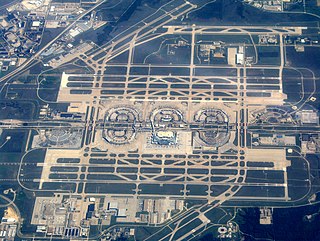
Dallas/Fort Worth International Airport, also known as DFW Airport or simply DFW, is the primary international airport serving the Dallas–Fort Worth metroplex and the North Texas Region in the U.S. state of Texas.

Will Rogers World Airport, a.k.a.Will Rogers Airport or simply Will Rogers, is a passenger airport located in Oklahoma City, Oklahoma, United States, about 6 miles (10 km) southwest of the city's downtown area. It is a civil-military airport on 8,081 acres of land. Although the official IATA and ICAO airport codes for Will Rogers World Airport are OKC and KOKC, it is common practice to refer to it as "WRWA" or "Will Rogers".

Braniff Airways, Inc., operated as Braniff International Airways from 1948 until 1965, and then Braniff International from 1965 until air operations ceased, was an airline in the United States that flew air carrier operations from 1928 until 1982 and continues today as a retailer, hotelier, travel service and branding and licensing company, administering the former airline's employee pass program and other airline administrative duties. Braniff's routes were primarily in the midwestern and southwestern United States, Mexico, Central America, and South America. In the late 1970s it expanded to Asia and Europe. The airline ceased air carrier operations in May 1982 because of high fuel prices, credit card interest rates and extreme competition from the large trunk carriers and the new airline startups created by the Airline Deregulation Act of December 1978. Two later airlines used the Braniff name: the Hyatt Hotels-backed Braniff, Inc. in 1983–89, and Braniff International Airlines, Inc. in 1991–92.

An automated guideway transit (AGT) or automated fixed-guideway transit or automatic guideway transit system is a type of fixed guideway transit infrastructure with a riding or suspension track that supports and physically guides one or more driverless vehicles along its length. The vehicles are often rubber tired or steel wheeled, but other traction systems including air cushion, suspended monorail and maglev have been implemented. The guideway provides both physical support, like a road, as well as the guidance.
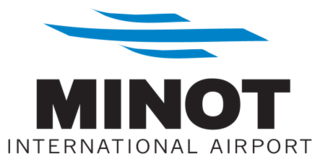
Minot International Airport is in Ward County, North Dakota, United States, two miles north of the city of Minot, which owns it. The National Plan of Integrated Airport Systems for 2011–2015 categorized it as a primary commercial service airport.

AirTrain is a fully automated people mover at San Francisco International Airport (SFO) that opened on February 24, 2003. It operates 24 hours a day on two separate lines, covering a total of three miles (4.8 km). The service charges no fares; it is funded by a fee charged to rental car customers. The system is located outside of the sterile area of each terminal, meaning passengers must exit and re-enter through a security checkpoint when using AirTrain to travel between terminals.
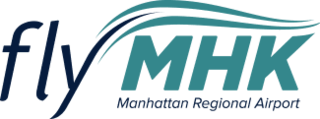
Manhattan Regional Airport in Riley County, Kansas, United States, is the second-busiest commercial airport in Kansas. It is owned by the city of Manhattan, Kansas, and is about five miles southwest of downtown Manhattan. American Airlines serves the airport with five daily flights to Chicago O'Hare International Airport and Dallas/Fort Worth International Airport. The airport is also used for general aviation and for planes chartered by the military and college sports teams.

The Terminal Link is an automated people mover (APM) at Toronto Pearson International Airport in Mississauga, Ontario, Canada. The wheelchair-accessible train runs 24 hours a day, seven days a week and is completely free-of-charge to ride. In 2012, it transported 17,000 passengers daily, 60 to 70% of whom were airport staff.

Skylink is an automated people mover (APM) operating at Dallas/Fort Worth International Airport (DFW). It is an application of the Innovia APM 200 system, and is maintained and operated by Alstom. When it opened in 2005, it was the world's longest airside airport train system.
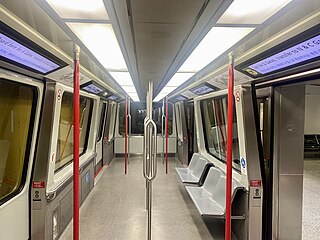
The SEA Underground, formerly called the Satellite Transit System (STS), is an automated people mover (APM) system operating in the Seattle–Tacoma International Airport in SeaTac, Washington, United States. Originally opening in 1973, the SEA Underground is one of the oldest airport people mover systems in the world. The APM was designed to quickly transport passengers to and from the North and South Satellites, and around the airport's Main Terminal.
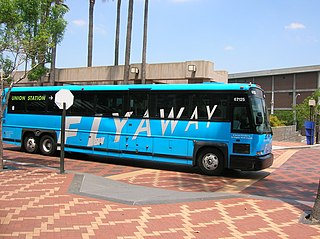
An airport bus, or airport shuttle bus or airport shuttle or Shuttle Bus is a bus used to transport people to and from, or within airports. These vehicles will usually be equipped with larger luggage space, and incorporate special branding. They are also commonly painted with bright colours to stand out among other airport vehicles and to be easily seen by the crews of taxiing aircraft when negotiating the aprons.

LTV's (Vought) Airtrans was an automated people mover system that operated at Dallas/Fort Worth International Airport between 1974 and 2005. The adaptable people mover was utilized for several separate systems: the Airport Train, Employee Train, American Airlines TrAAin and utility service. All systems utilized the same guideways and vehicle base but served different stations to create various routes.

The PHX Sky Train is an electric people mover at Phoenix Sky Harbor International Airport in Phoenix, Arizona. The initial segment opened to the public on April 8, 2013. The first extension to Terminal 3 opened on December 8, 2014, and the second extension to the Rental Car Center opened on December 20, 2022. The 24/7 service operates free of charge, with trains running every 3–5 minutes.
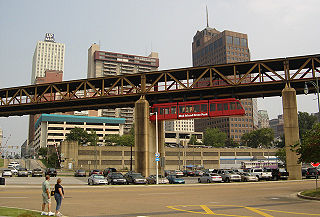
A suspension railway is a form of elevated monorail in which the vehicle is suspended from a fixed track, which is built above streets, waterways, or existing railway track.

Dallas Love Field is a city-owned public airport 6 miles (9.7 km) northwest of downtown Dallas, Texas. It was Dallas' main airport until 1974 when Dallas/Fort Worth International Airport (DFW) opened. Love Field covers an area of 1,300 acres (530 ha) at an elevation of 487 feet (148 m) above mean sea level and has two runways.
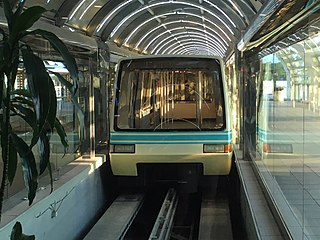
The Orlando International Airport People Movers are a set of automated people mover (APM) systems operating within Orlando International Airport. The four original people mover systems connect the airport's main terminal to four satellite airside concourses. A fifth AGT people mover system was installed in 2017 to connect the main terminal with the airport's new Intermodal Terminal.

The Tampa International Airport People Movers are a set of automated people mover systems operating within Tampa International Airport. The primary set of people movers are automated guideway transit (AGT) systems that connect the airport's main terminal to four satellite airside concourses. Opened in 1971, the landside/airside shuttles were the first people movers used to transport passengers within an airport terminal and it is today Bombardier Transportation's longest running people mover system. A fifth people mover line known as SkyConnect, which began operating in 2018, connects the main terminal with the airport's economy parking garage and rental car center. In addition, a monorail once connected the main terminal and the long-term parking garage from 1991 until its closure in 2020.
This is the history of Braniff International Airways.
References
- 1 2 3 4 5 "The Advanced Monorail That Pays for Itself by George P. Scelzo" (PDF). Archived from the original (PDF) on 23 July 2011. Retrieved 25 November 2009.
- ↑ "Will new airport tram be son of Jetrail?" Dallas Morning News, 11/17/2002
- 1 2 "Lessons from the History of Personal Rapid Transit (PRT) by J. Edward Anderson" . Retrieved 25 November 2009.
- ↑ "Jetrail Use Started By Braniff," Dallas Morning News, 04/21/1970
- ↑ "Shuttle car not that far in the future" The Dallas Times Herald, 12/22/1974
- ↑ "Report on the Feasibility of the Braniff Jetrail Operation in Waco, Texas". Archived from the original on 10 June 2011. Retrieved 25 November 2009.
- ↑ "Deal Falls through for Jetrail Sale". Dallas Morning News . 20 September 1975.